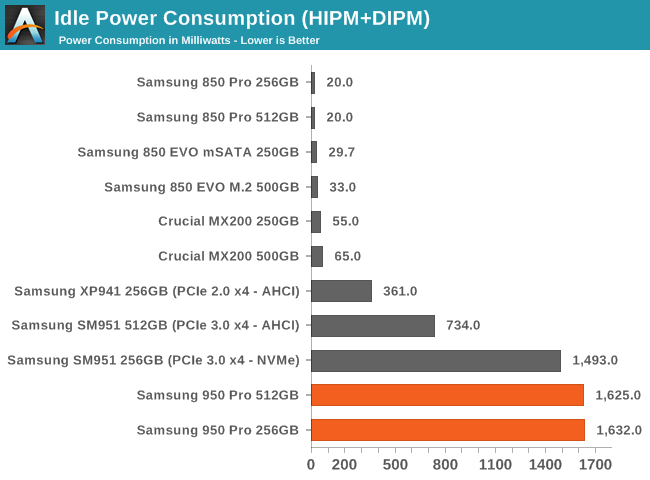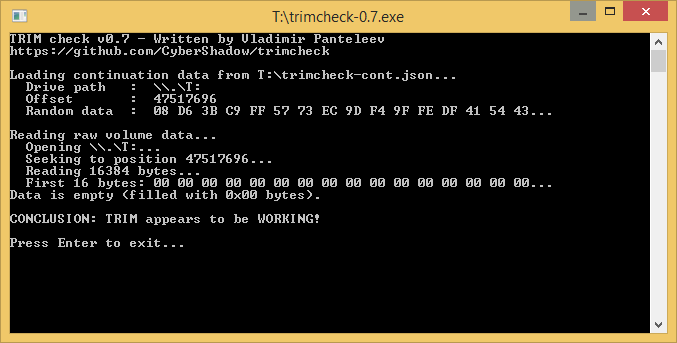The Samsung 950 Pro PCIe SSD Review (256GB and 512GB)
by Billy Tallis on October 22, 2015 10:55 AM ESTIdle Power Consumption
The idle power consumption I'm reporting here and in the Bench database is what's achievable on our 2015 testbed with PCIe ASPM disabled for the sake of system stability. Samsung's initial announcement of the 950 Pro specified an idle power consumption of 1.7W, which these drives manage to stay under. Samsung's later specs mention 70mW idle and 2.5mW DevSlp power draw. The former figure is something we hope to be able to verify in the future, but our power meter isn't sensitive enough for measuring DevSlp power.

As stated earlier, the power numbers for the PCIe drives are more of a worst-case scenario, due to our testbed being unable to enable their power saving modes. These active idle power levels have nevetheless been growing with each new PCIe drive from Samsung.
Trim Validation
Strictly speaking, NVMe doesn't have the TRIM command. The NVMe Deallocate command is the equivalent to the ATA Trim command, and since the trimcheck tool relies on the OS and filesystem to issue the command, it works without modification on NVMe drives.











142 Comments
View All Comments
Billy Tallis - Thursday, October 22, 2015 - link
If I'd had more time, I probably would have done more informal testing on some older machines. I can at least assure you that the drive doesn't seem to have any trouble in a PCIe 2.0 x2 M.2 slot on my personal Haswell machine. Next time I'm poking around in my Lynnfield server I'll be checking how the pcie drives work, especially power management. But I probably won't do a full suite of performance tests, just enough to get a rough idea for how fast drives perform on a slower link. And I really don't have a clue when I'll get around to this, because I've still got quite the backlog of drives to review.hansmuff - Thursday, October 22, 2015 - link
Understandable, thanks for the PCIe 2.0 update.The_Assimilator - Thursday, October 22, 2015 - link
Thermal throttling is disappointing but shows that M.2, like SATA Express, is DOA. PCIe drives with heatsinks, or preferably U.2, is the future - hopefully with the Z200 series chipsets, manufacturers will ditch SATAe in favour of U.2 and we can finally get a worthy successor to SATA3.MrSpadge - Thursday, October 22, 2015 - link
DOA it certainly is not. You're free to attach a tiny RAM heatsink on the drive and be fine. Or simply forget about throtteling in real world usage (unless you use it in a server).Redstorm - Thursday, October 22, 2015 - link
Under a normal client workload you don't get anywhere near triggering the thermal protection so adding heat sinks is not required. Agree SATA Express was still born. M.2 is far from it, if you look at any new release ultrabook you will find a M.2 SSD under the lid.The_Assimilator - Friday, October 23, 2015 - link
M.2 is a great solution for replacing 2.5" SSDs in space-limited applications like ultrabooks, but for *absolute maximum performance without thermal throttling*, 2.5" U.2 drives a la Intel's 750 are still the way to go.zodiacfml - Sunday, October 25, 2015 - link
It depends on the designer on how much throttling they would allow or not. U.2 allows more freedom though but I reckon would be much more expensive and less dense in the future.user_5447 - Thursday, October 22, 2015 - link
Why everyone keep saying that BIOS/UEFI must support NVMe to boot into OS?You can install GRUB bootloader on cheap small USB flash drive and use it to boot from NVMe drives on any system, since GRUB itself supports NVMe for few years now.
And yes, GRUB supports booting into Windows 8.1 / 10.
bji - Thursday, October 22, 2015 - link
They say it because it's true. Nobody wants to have to manage a USB drive just for booting their system. You can also install a floppy drive and boot from that, would you recommend that also? How about keeping a separate computer up constantly to support PXE booting from the network? Would you recommend that level of headache to someone who just wants to boot their frickin computer?bji - Thursday, October 22, 2015 - link
By the way, of all of the things I have to deal with when installing/upgrading Linux systems, grub is the most painful and problematic, by MANY orders of magnitude. I would *NEVER* recommend that a non-technical user have anything to do with grub, especially not for something as silly as booting a PC into Windows off of an NVMe drive.